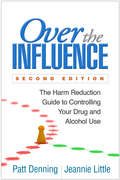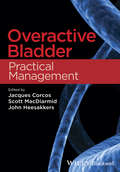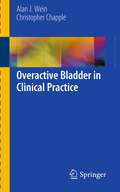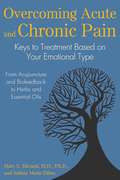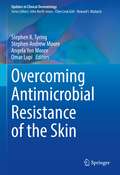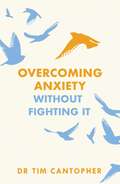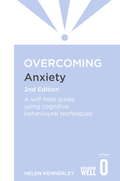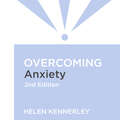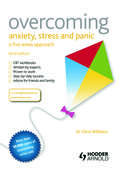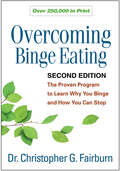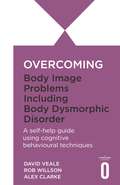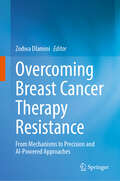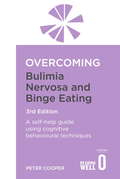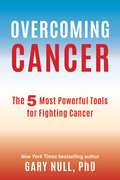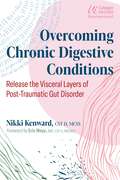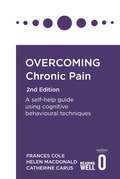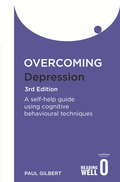- Table View
- List View
Over the Influence, Second Edition: The Harm Reduction Guide to Controlling Your Drug and Alcohol Use
by Patt Denning Jeannie Little"Just say no" just doesn't work for everyone. If you've tried to quit and failed, simply want to cut down, or wish to work toward sobriety gradually, join the many thousands of readers who have turned to this empathic, science-based resource--now thoroughly revised. A powerful alternative to abstinence-only treatments, harm reduction helps you set and meet your own goals for gaining control over alcohol and drugs. Step by step, the expert authors guide you to figure out: *Which aspects of your habits may be harmful. *How to protect your safety and make informed choices. *What changes you would like to make. *How to put your intentions into action. *When it's time to seek help--and where to turn. Updated to reflect a decade's worth of research, the fully revised second edition is even more practical. It features additional vivid stories and concrete examples, engaging graphics, new worksheets (which you can download and print for repeated use), "Self-Reflection" boxes, and more. Mental health professionals, see also the authors' Practicing Harm Reduction Psychotherapy, Second Edition.
Overactive Bladder
by Scott Macdiarmid Jacques Corcos John HeesakkersOveractive Bladder: Practical Management provides urologists, gynecologists and other health practitioners with a comprehensive clinical guide to this very common problem, resulting in a perfect resource to consult time and time again. Beginning with an introductory section covering the definition and pathophysiolgy of OAB, it then moves on to cover evaluation, first-line management, second-line management and finally surgery. Well-illustrated throughout, each chapter begins with a key points box outlining the most important take-home messages. Also included are clear management algorithms to aid decision-making, 'Do's and Don't' boxes to help avoid errors made, key references to the top journal articles, and the very latest guidelines from the EAU, AUA and other major urology societies. Chapters are written by the top names in the field and the entire book is expertly edited by Jacques Corcos, John Heesakkers and Scott MacDiarmid. The result is a consistent, comprehensive and fully up to date approach to OAB, providing urologists managing patients with this condition with rapid access, specialist clinical guidance.
Overactive Bladder in Clinical Practice
by Alan J. Wein Christopher R. ChappleThe book provides a timely and comprehensive update on the overactive bladder (OAB) syndrome. The symptoms of urgency, with or without urge incontinence, usually with frequency or nocturia, now defined as the overactive bladder syndrome, have become a hot topic in urology, gynecology and urogynecology. Epidemiological data show very high disease prevalence (19%), particularly when compared with other chronic conditions such as diabetes (2%) and asthma (7%). OAB symptoms impact severely on patient's quality of life, causing significant impairment of patient vitality and limiting their physical role, similar to diabetes. The OAB syndrome involves all age groups, both sexes and is frequently found in neurogenic patients. This book will cover all aspects of OAB epidemiology, economics, pathophysiology, conservative, pharmaceutical and surgical and will be invaluable reading for residents and trainees in urology, gynecology and urogynecology.
Overcoming Acute and Chronic Pain: Keys to Treatment Based on Your Emotional Type
by Marc S. Micozzi Sebhia Marie DibraFind the holistic treatment that will work best for you based on your emotional type and specific pain condition• Provides an easy questionnaire to determine your emotional type and an interactive self-assessment for finding the right pain treatment for your condition• Explores mind-body treatments for many common pain conditions, including arthritis, back pain, fibromyalgia, irritable bowel, migraines, carpal tunnel, and PTSD• Reviews the scientific evidence in support of acupuncture, biofeedback, hypnosis, massage, chiropractic, yoga, herbs, and essential oilsThroughout history many healing traditions have focused on analgesia--the alleviation of pain--an area in which modern medicine provides few options beyond narcotics, steroids, and surgery. For those seeking drug- and surgery-free alternatives or complements to conventional pain management, the choices can be overwhelming. How do you know which method will work for you?In this guide to safe and effective natural therapies for acute and chronic pain, authors Marc S. Micozzi, M.D., Ph.D., and Sebhia Marie Dibra explain how your emotional boundary style--how you react to emotional, social, environmental, and physical stresses--affects which complementary treatments will work best for you. Providing an easy questionnaire to determine your emotional type and an interactive self-assessment for finding the right pain treatment for your condition, they explore the effectiveness of mind-body treatments for each emotional type and for many common pain disorders, including arthritis, back pain, fibromyalgia, irritable bowel, ulcer, migraine headaches, carpal tunnel, anxiety, PTSD, and other chronic pain conditions. They review the available research and scientific evidence in support of each therapy, suggesting only well-established, safe, and clinically proven alternative treatments, such as acupuncture, biofeedback, hypnosis, massage, chiropractic, yoga, herbs, and essential oils.Approaching pain holistically, they reveal how pain should be understood as a dynamic condition--an interaction between mind and body as well as between patient and therapy--and how your emotional type is key to long-lasting and successful results.
Overcoming Anger and Irritability, 2nd Edition: A self-help guide using cognitive behavioural techniques
by Dr William DaviesConstant irritability or flashes of bad temper can cause difficulties in relationships with friends, family or colleagues and leave us feeling unhappy and exhausted. This fully updated and revised edition of William Davies' bestselling title is for anyone struggling to control their rage and regretting inappropriate reactions.It explains clearly what provokes anger and what we can do to prevent it. Techniques based on Cognitive Behavioural Therapy (CBT) offer a positive approach with long-term goals in mind and show how you can stay cool and successfully handle situations that would tax even the most easy-going person.Overcoming self-help guides use clinically-proven techniques to treat long-standing and disabling conditions, both psychological and physical. READING WELL This book is recommended by the national Reading Well Books on Prescription scheme for England delivered by The Reading Agency and the Society of Chief Librarians with funding from Arts Council England and Wellcome. www.reading-well.org.uk
Overcoming Anger and Irritability, 2nd Edition: A self-help guide using cognitive behavioural techniques (Overcoming Books)
by Dr William DaviesConstant irritability or flashes of bad temper can cause difficulties in relationships with friends, family or colleagues and leave us feeling unhappy and exhausted. This fully updated and revised edition of William Davies' bestselling title is for anyone struggling to control their rage and regretting inappropriate reactions.It explains clearly what provokes anger and what we can do to prevent it. Techniques based on Cognitive Behavioural Therapy (CBT) offer a positive approach with long-term goals in mind and show how you can stay cool and successfully handle situations that would tax even the most easy-going person.Overcoming self-help guides use clinically-proven techniques to treat long-standing and disabling conditions, both psychological and physical. READING WELL This book is recommended by the national Reading Well Books on Prescription scheme for England delivered by The Reading Agency and the Society of Chief Librarians with funding from Arts Council England and Wellcome. www.reading-well.org.uk
Overcoming Anger in Your Relationship
by W. NayHas your relationship become a battlefield? Does your partner's sarcasm, irritability, or hostility make you wonder where the closeness and trust have gone-and how much more you can take? If anger is poisoning your relationship, this book offers a powerful antidote. Anger expert W. Robert Nay provides clear-cut, practical techniques for responding productively to inappropriate expressions of anger. Learn how anger gains a foothold in a couple's life, why your usual responses may unwittingly reward bad behavior, and how to stand up for yourself in ways that promote lasting change. Self-quizzes and step-by-step suggestions for dealing with different types of angry behavior are illustrated with true-to-life examples. Grounded in psychological science, the strategies in this book are simple yet surprisingly effective. Try them for yourself-and for the person you love.
Overcoming Antimicrobial Resistance of the Skin (Updates in Clinical Dermatology)
by Stephen K. Tyring Omar Lupi Angela Yen Moore Stephen Andrew MooreThis book is a thorough, practical review of the challenges facing clinicians treating skin microbes and how to combat these therapeutic dilemmas. It expresses the critical public health concern of antimicrobial resistance and shows how microorganisms are developing the ability to halt the progress of antimicrobials like antibiotics, antivirals, and antifungals. Chapters are grouped together in five sections for ease of use. The first three sections of the book convey foundational information on the mechanisms of antibiotics, antivirals, and antifungals resistance, as well as the implications of lack of vaccination. The fourth section then turns to the specifics of drug resistance for protozoan and helminth infections focusing primarily on initial and subsequent resistance to treatment. The book closes with a discussion on the potential solutions of innovative therapy including new delivery mechanisms, broad-spectrum antibiotics, phytocompounds, and biofilms. Chapters feature magnified, microscopic photos for identifying structures as they appear on the skin. Part of the Updates in Clinical Dermatology series, Overcoming Antimicrobial Resistance of the Skin is an important resource relevant during the COVID-19 pandemic, and is written for all medical healthcare professionals.
Overcoming Anxiety Without Fighting It: The powerful self help book for anxious people from Dr Tim Cantopher, bestselling author of "Depressive Illness: The Curse of the Strong"
by Tim CantopherYOU DON'T HAVE TO STRUGGLE WITH ANXIETY. WHETHER YOU DEVELOPED IT RECENTLY, OR YOU'VE BEEN LIVING WITH IT FOR YEARS, YOUR ANXIETY CAN BE TREATED. Expert psychiatrist and bestselling author Dr Tim Cantopher has helped hundreds of people just like you, and in Overcoming Anxiety Without Fighting It, he gives you tried and proven strategies for escaping the fear that stalks you. Discover a series of simple, manageable lifestyle skills and strategies that will make an immediate difference to your life, as well as practical suggestions for longer-term changes, including advice on how, when, and what sort of professional help to seek. At the heart of this warm, supportive and expert book are the author's decades of experience with people just like you, and with this experience comes a message of hope, and reassurance. Stick with the changes you are going to make, and seek the support you need, and your life will no longer be dominated by fear.'I'm speaking to you now - if you are going to gain the relief from your symptoms which I hope for you, you'll need to promise me and yourself one thing from the start: that you'll try your hardest not to judge yourself and how well or badly you're doing at getting better.' - Dr Tim Cantopher
Overcoming Anxiety Without Fighting It: The powerful self help book for anxious people from Dr Tim Cantopher, bestselling author of "Depressive Illness: The Curse of the Strong"
by Tim Cantopher'I'm speaking to you now - if you are going to gain the relief from your symptoms which I hope for you, you'll need to promise me and yourself one thing from the start: that you'll try your hardest not to judge yourself and how well or badly you're doing at getting better.' - Dr Tim CantopherWhether you developed it recently, or have been living with it for years, your anxiety can be treated. Expert psychiatrist and bestselling author Tim Cantopher has helped hundreds of people like you, and in Overcoming Anxiety Without Fighting It, he'll give you tried and proven strategies for escaping the fear that stalks you. The first step on the path to feeling better is to accept your anxiety, and to stop struggling with it. While you come to terms with this, Dr Cantopher will set out a series of simple, manageable lifestyle skills and strategies that will make an immediate difference. There are also practical suggestions for longer-term changes - and advice on how, when, and what sort of professional help to seek. At the heart of this warm, supportive and expert book are the author's decades of experience with people just like you, and with this experience comes a message of hope, and reassurance. Stick with the changes you are going to make, and seek the support you need, and your life will no longer be dominated by fear.
Overcoming Anxiety, 2nd Edition: A self-help guide using cognitive behavioural techniques
by Helen KennerleyOvercoming app now available.Fully updated edition of the bestselling self-help book, now recommended on the national Books on Prescription scheme. This ever-popular guide offers a self-help programme, written by one of the UK's leading authorities on anxiety and based on CBT, for those suffering from anxiety problems. A whole range of anxieties and fears are explained, from panic attacks and phobias to obsessive compulsive disorder (OCD) and generalised anxiety. It includes an introduction to the nature of anxiety and stress and a complete self-help programme with monitoring sheets based on Cognitive Behavioural Therapy. The following websites may offer useful further information on anxiety disorders: www.social-anxiety.org.uk www.stress.org.uk www.triumphoverphobia.com
Overcoming Anxiety, 2nd Edition: A self-help guide using cognitive behavioural techniques (Overcoming Books)
by Helen KennerleyHIGHLY COMMENDED for the British Medical Awards book prize for Popular MedicineFully updated edition of the bestselling self-help book, now recommended on the national Reading Well scheme. This ever-popular guide offers a self-help programme, written by one of the UK's leading authorities on anxiety and based on CBT, for those suffering from anxiety problems. A whole range of anxieties and fears are explained, from panic attacks and phobias to obsessive compulsive disorder (OCD) and generalised anxiety. It includes an introduction to the nature of anxiety and stress and a complete self-help programme with monitoring sheets based on Cognitive Behavioural Therapy. The following websites may offer useful further information on anxiety disorders: www.social-anxiety.org.uk www.stress.org.uk www.triumphoverphobia.com
Overcoming Anxiety, Stress and Panic: A Five Areas Approach (Overcoming)
by Christopher WilliamsOvercoming Anxiety, Stress and Panic uses the proven and trusted five areas model of cognitive behavioural therapy (CBT) to help people experiencing a range of symptoms associated with these conditions. For the third edition, new workbooks are included on: obsessive compulsive disorder (OCD), using medication, and planning for the future.CBT workbo
Overcoming Binge Eating, Second Edition
by Christopher G. FairburnThis trusted bestseller provides all the information needed to understand binge eating and bring it under control, whether you are working with a therapist or on your own. Clear, step-by-step guidelines show you how to: *Overcome the urge to binge. *Gain control over what and when you eat. *Break free of strict dieting and other habits that may contribute to binges. *Establish stable, healthy eating patterns. *Improve your body image and reduce the risk of relapse. This fully updated second edition incorporates important advances in the understanding and treatment of eating disorders. It features expanded coverage of body image issues and enhanced strategies for achieving--and maintaining--a transformed relationship with food and your body.
Overcoming Body Image Problems including Body Dysmorphic Disorder
by Rob Willson Alex Clarke David VealeMany people occasionally suffer from a negative body self-image but, for an increasing number of people, this can turn into a more serious preoccupation. One per cent of the population will develop Body Dysmorphic Disorder (BDD), a condition characterised by severe preoccupation with a perceived physical defect. Body image problems can cause significant distress and can lead to further problems such as anxiety, eating disorders and social phobia. It has long been recognised that negative body image problems are a factor in the onset and maintenance of many eating disorders. However, they can be successfully treated with cognitive behavioral therapy (CBT).Praise for Overcoming Obsessive Compulsive Disorder and the Overcoming series:'[Overcoming Obsessive Compulsive Disorder] is an affordable and highly recommended read.'The Psychologist'The best consumer-friendly CBT-based books...All are very thorough.'Observer
Overcoming Breast Cancer Therapy Resistance: From Mechanisms to Precision and AI-Powered Approaches
by Zodwa DlaminiThis book addresses the pressing problem of drug resistance in the treatment of breast cancer. It provides a comprehensive understanding of the complex mechanisms underlying drug resistance and presents the latest advances in therapeutic approaches to overcome this enormous challenge. The book begins with an introduction to the biology of breast cancer, treatment modalities and the mechanisms of drug resistance. This includes the principles of drug resistance in targeted, immune-, endocrine and chemotherapy. In the following sections, the authors present innovative strategies to overcome drug resistance and new research directions, among others the role of the microbiome in drug resistance, molecular profiling of patients for personalized medical care, and new drug delivery systems. Finally, the book concludes with a discussion of the differences in the prevalence and treatment success of breast cancer between high- and low-income countries. This book is an informative resource for students, researchers, and clinicians in the field of breast cancer research and oncology in general.
Overcoming Bulimia Nervosa and Binge Eating 3rd Edition: A self-help guide using cognitive behavioural techniques
by Prof Peter CooperAs many as one in 20 women in the western world suffer bouts of uncontrolled binge-eating. Going without food for long periods, making yourself vomit and taking laxatives you don't need are also common and are symptoms of bulimia nervosa. Such illness costs lives if not successfully treated.Now in its second edition, Peter Cooper's sympathetic and highly acclaimed guide gives a clear explanation of the disorder and the serious health issues that can result from it. He describes the treatments available today and, most importantly, sets out a self-help guide for those who want to tackle their difficulties for themselves, with a step-by-step programme. This is a real chance for sufferers to take the road to recovery, and will give their friends and family a much clearer understanding of the illness and its remedy.
Overcoming Cancer: The 5 Most Powerful Tools for Fighting Cancer
by Gary NullOne word strikes more fear into a person’s mind than any other: cancer. The physical, mental, emotional, and financial toll that comes with a cancer diagnosis is immense and affects not only cancer patients but also families and entire communities. The vast majority of individuals who lose the battle against cancer are treated with the standard orthodox therapy. These people may never have questioned their oncologists, believing that they were in the best possible hands with their physicians’ advanced education, their knowledge of the latest treatments, and all the tools of modern research at their disposals.In Overcoming Cancer, Gary Null explores the alternative treatments that most mainstream doctors will never discuss with their patients. Did you know that eating melons balances your body’s pH, which can help slow the growth of cancer? You were aware that fiber is an important part of a healthy diet, but did you know that it lowers the risk of breast, colorectal, uterine, and prostate cancers? Find health and vitality with Dr. Null’s five most powerful tools for fighting cancer.
Overcoming Chronic Digestive Conditions: Release the Visceral Layers of Post-Traumatic Gut Disorder
by Nikki KenwardA holistic approach for healing trauma stored in the gut• Explains how and why emotions and trauma are stored in the gut, causing digestive issues and visceral tensions • Presents recent research that enriches our understanding of the gut as a center of emotional and spiritual growth • Shares a hands-on process of listening to the gut layer by layer to help heal gut issues, renew the microbiome, and release intergenerational trauma A healthy gut is fundamental to a healthy life. Embedded within our digestive system is the enteric nervous system, our &“second brain,&” which serves to protect us from the external world of adversity, including not only viruses and bacteria, but also traumatic events. As Nikki Kenward, CST-D, MCSS, explains, past challenges and traumas, whether emotional or physical, are held in the enteric nervous system in many ways, including fascial tension, cellular changes, and unhelpful &“default settings.&” Exploring in depth what she calls &“the Post-Traumatic Gut,&” Kenward describes the anatomy and physiology of the enteric nervous system, including the polyvagal system, and the many ways that our emotional history and current emotional state can impact our digestive system. Sharing recent research, she describes the science behind the emotional gut and how to apply it to chronic digestive issues like IBS and Crohn&’s disease as well as mental health issues such as anorexia, bulimia, anxiety, and depression. She explains how and why the digestive gut absorbs emotions and what you can do to heal its functions by addressing psychosomatic stressors, rather than just nutrition. Presenting case studies from her 25 years in clinical practice as well as her own healing journey, she reveals the synchronicity between digestive/metabolic functions and psychological/perceptual insight and how allowing the cells to &“speak&” through bodywork such as CranioSacral Therapy and SomatoEmotional Release Therapy can help renew the microbiome of the second brain, release intergenerational trauma and illness, and restore one&’s psychospiritual life. Sharing visualization exercises and a hands-on process of listening to the gut layer by layer, the author helps readers unwind stagnant cellular patterns, discover the dynamic intelligence in every cell, and transform Post-Traumatic Gut into Post-Traumatic growth.
Overcoming Chronic Pain 2nd Edition: A self-help guide using cognitive behavioural techniques
by Helen Macdonald Frances Cole Catherine CarusTake control of your life, take control of your painChronic pain can be extremely debilitating; however, it does not need to dominate your life. This self-help book is based on highly effective self-help methods developed by specialists and used in community and hospital pain management programmes. Your experience of pain can be greatly reduced by pacing daily activities, reducing stress, learning relaxation techniques and effective ways to cope with depression, anxiety, worry, anger and frustration.This easy-to-follow book sets out:- Why pain can persist when there's no injury or disease present- How to become fitter and pace your activities- Practical ways to improve sleep and relaxation- Tips for returning to work, study and gaining a life you valueOvercoming self-help guides use clinically proven techniques to treat long-standing and disabling conditions, both psychological and physical.This book is recommended by the national Reading Well scheme for England delivered by The Reading Agency and the Society of Chief Librarians with funding from Arts Council England and Wellcome.
Overcoming Chronic Pain 2nd Edition: A self-help guide using cognitive behavioural techniques (Overcoming Books)
by Helen Macdonald Catherine Carus Dr. Frances ColeTake control of your life, take control of your painChronic pain can be extremely debilitating; however, it does not need to dominate your life. This self-help book is based on highly effective self-help methods developed by specialists and used in community and hospital pain management programmes. Your experience of pain can be greatly reduced by pacing daily activities, reducing stress, learning relaxation techniques and effective ways to cope with depression, anxiety, worry, anger and frustration.This easy-to-follow book sets out:- Why pain can persist when there's no injury or disease present- How to become fitter and pace your activities- Practical ways to improve sleep and relaxation- Tips for returning to work, study and gaining a life you valueOvercoming self-help guides use clinically proven techniques to treat long-standing and disabling conditions, both psychological and physical.This book is recommended by the national Reading Well scheme for England delivered by The Reading Agency and the Society of Chief Librarians with funding from Arts Council England and Wellcome.
Overcoming Depersonalisation and Feelings of Unreality, 2nd Edition: A self-help guide using cognitive behavioural techniques
by Anthony David Emma Lawrence Dawn BakerDepersonalization Disorder is when a person experiences a feeling of being detached from life around them and sometimes emotionally numb. It is often a symptom of another disorder such as anxiety, depression, posttraumatic stress disorder and particularly panic disorder, or of an illness like epilepsy or migraine, but also occurs in its own right and among users of certain drugs. CBT is an effective treatment.PRAISE FOR THE SERIES: 'The best consumer-friendly CBT-based books&All are very thorough.' Observer 'The Overcoming series just keeps getting better and better.' The Psychologist
Overcoming Depersonalisation and Feelings of Unreality, 2nd Edition: A self-help guide using cognitive behavioural techniques
by Anthony David Emma Lawrence Dawn Baker Elaine Hunter'The first of its kind, this self-help book will offer guidance, help and solace to the many sufferers of depersonalization disorder.'Daphne Simeon, Depersonalisation and Dissociation Program, Mount Sinai School of Medicine, New YorkDepersonalization disorder can make you feel detached from life and many people describe feeling 'emotionally numb', unreal or even as if their body doesn't belong to them. It can be a symptom of another problem such as anxiety, depression, post-traumatic stress disorder and, particularly, of panic disorder, or of an illness like epilepsy or migraine. It can also occur in its own right and/or as a side effect of certain drugs.This self-help book, written by leading experts, will help you to understand what causes depersonalization disorder and what can keep it going, and will introduce you to effective strategies to overcome it:Based on clinically proven cognitive behavioural therapy (CBT) techniques Clear and accessible step-by-step exercises and tools, including diary-keeping and problem-solving Overcoming self-help guides use clinically proven techniques to treat long-standing and disabling conditions, both psychological and physical. Many guides in the Overcoming series are recommended under the Reading Well Books on Prescription scheme.Series Editor: Professor Peter Cooper
Overcoming Depersonalisation and Feelings of Unreality: A self-help guide using cognitive behavioural techniques (Overcoming Ser.)
by Anthony David Emma Lawrence Dawn Baker'The first of its kind, this self-help book will offer guidance, help and solace to the many sufferers of depersonalization disorder.'Daphne Simeon, Depersonalisation and Dissociation Program, Mount Sinai School of Medicine, New YorkDepersonalization disorder can make you feel detached from life and many people describe feeling 'emotionally numb', unreal or even as if their body doesn't belong to them. It can be a symptom of another problem such as anxiety, depression, post-traumatic stress disorder and, particularly, of panic disorder, or of an illness like epilepsy or migraine. It can also occur in its own right and/or as a side effect of certain drugs.This self-help book, written by leading experts, will help you to understand what causes depersonalization disorder and what can keep it going, and will introduce you to effective strategies to overcome it:Based on clinically proven cognitive behavioural therapy (CBT) techniques Clear and accessible step-by-step exercises and tools, including diary-keeping and problem-solving Overcoming self-help guides use clinically proven techniques to treat long-standing and disabling conditions, both psychological and physical. Many guides in the Overcoming series are recommended under the Reading Well Books on Prescription scheme.Series Editor: Professor Peter Cooper
Overcoming Depression 3rd Edition: A self-help guide using cognitive behavioural techniques
by Paul GilbertOvercoming app now available via iTunes and the Google Play Store.A Books on Prescription TitleBreak free from the hell of depressionIf you suffer from depression you are far from alone. Depression is very common, affecting over 300 million people around the world. Written by Professor Paul Gilbert, internationally recognised for his work on depression, this highly acclaimed self-help book has been of benefit to thousands of people including sufferers, their friends and families, and those working in the medical profession.This fully revised third edition has been extensively updated and rewritten to reflect over ten years of new research on understanding and treating depression, particularly the importance of developing compassionate ways of thinking, behaving and feeling. It contains helpful case studies and new, easy-to-follow, step-by-step suggestions and exercises to help you understand your depression and lift your mood.
